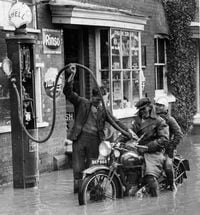Fuel prices have been pretty stable over the past months, which might indicate not much is changing in the petroleum world. Don’t let the current lack of price activity fool you—there’s plenty happening in the oil business that’s worth looking at.
After the precipitous fall in oil prices last year, from more than $100 down to the $40-per-barrel range, prices have risen to the $60 range and have stayed there for months. Compared to $100, $60 is still a low price, and the basic drivers for the low price remain the same: strong production and supply combined with reduced demand in many areas.
To put reduced demand in perspective, the highest number of miles driven in the US (Peak Driving) happened in 2005. Our miles driven today are down about 9 percent from the peak. Peak vehicle ownership happened in 2006, and the number of vehicles owned per person is down about 7 percent. Airline departures are down even more, about 16 percent below their 2005 peak. Average fuel efficiency has increased incrementally, further reducing fuel use, so, for the US at least, fuel demand is significantly lower than it was 10 years ago.
At the same time, supply has been at an all-time high. In the US, large production increases have come from hydraulic fracturing (or fracking) in oil-bearing shale—so-called “tight oil.” This is expensive oil because the fracking process is costly and the wells are not high producers relative to conventional wells. Oil produced from Canadian tar sands is likewise very expensive oil. When oil was $100-plus per barrel, these production techniques made money, but at current prices the situation isn’t bright. The break-even point for most tight-oil producers averages more than $100 per barrel, so these operations are not profitable at present. The drill-rig count has been dropping, and workers are being laid off in serious numbers. US production is just starting to show some decline, and that decline looks to accelerate soon.
Worldwide, demand is both up and down. In countries like Japan and Italy oil consumption is down much more than in the US—more than 25 percent. China and India, however, continue to show large demand increases, leading to slightly increased overall demand worldwide.
Asia may soon present supply problems. Total Asian production is at 8.3 mb/d (million barrels per day) with Asian consumption hovering around 30.9 mb/d. The 22.6 mb/d shortfall is currently covered by imports—a serious dependency on (sometimes unreliable) Middle Eastern sources.
Of 48 petroleum-producing countries, only 10 are seeing production increases. Seventeen countries have either flat production or are dealing with political instability that makes production uncertain. And 21 countries, among them some previously strong producers, report declining production.
With both worldwide petroleum supply and demand more or less stable right now, we in the US are enjoying a run of smooth riding, with reasonable fuel prices that aren’t changing much. But big forces are at work, some of which are very unpredictable. Demand will probably remain fairly stable, if not decrease somewhat. It’s the supply side that looks to hold surprises.
We’ve seen the US tight-oil supply threatened by unprofitable operation at current prices. OPEC countries that are presently strong producers are under similar pressure and are also needing to keep more of their oil for domestic use as their economies grow, leaving less oil available for export. And in many areas there is always the wild card of war and political instability that may cut off production and/or complicate the transport of oil. Some predict lower prices; some predict higher prices. What we do know from the price spike of 2008 and the price drop of 2014 is that almost no one predicted these accurately. Let’s enjoy the current stability and keep an eye out for the wild swings.
While we’re not exactly up to our ankles in extra fuel, reduced demand in the US has helped keep fuel prices low.
James Parker designed his first original motorcycle in 1971; his most recent design is the Mission R electric superbike. In between, he worked on multiple other motorcycle projects, including 30 years spent evolving the RADD front suspension system used on the Yamaha GTS1000 and various other prototypes.












/cloudfront-us-east-1.images.arcpublishing.com/octane/OKWOJWAKP5EP3OACCRRWPCIX2Q.jpg)
/cloudfront-us-east-1.images.arcpublishing.com/octane/2WF3SCE3NFBQXLDNJM7KMXA45E.jpg)
/cloudfront-us-east-1.images.arcpublishing.com/octane/G4MG6OUCJNBSHIS2MVVOTPX65E.jpg)
/cloudfront-us-east-1.images.arcpublishing.com/octane/IIGGWFOTOJGB7DB6DGBXCCMTDY.jpg)
/cloudfront-us-east-1.images.arcpublishing.com/octane/QSTCM6AVEZA5JJBUXNIQ3DSOF4.jpg)
/cloudfront-us-east-1.images.arcpublishing.com/octane/U4I7G625B5DMLF2DVIJDFZVV6M.jpg)
/cloudfront-us-east-1.images.arcpublishing.com/octane/B6XD6LS6IVCQPIU6HXDJSM3FHY.jpg)
/cloudfront-us-east-1.images.arcpublishing.com/octane/ICL63FEDDRDTTMINYICCEYGMDA.jpg)
/cloudfront-us-east-1.images.arcpublishing.com/octane/FCGZHQXRBZFLBAPC5SDIQLVF4I.jpg)
/cloudfront-us-east-1.images.arcpublishing.com/octane/WNOB6LDOIFFHJKPSVIWDYUGOPM.jpg)

/cloudfront-us-east-1.images.arcpublishing.com/octane/X33NU3E525ECRHXLNUJN2FTRKI.jpg)
/cloudfront-us-east-1.images.arcpublishing.com/octane/6KKT5NNL2JAVBOXMZYS5ZO76YA.jpg)
/cloudfront-us-east-1.images.arcpublishing.com/octane/J5RKG5O455GMPGQRF2OG6LRT7A.jpg)
/cloudfront-us-east-1.images.arcpublishing.com/octane/GX2CIZKQVRH2TATDM26KFG2DAE.jpg)
/cloudfront-us-east-1.images.arcpublishing.com/octane/ZWIDYSAKQZHD5BHREMQILXJCGM.jpg)
/cloudfront-us-east-1.images.arcpublishing.com/octane/CYUHJZCTSJCH3MRAQEIKXK7SCQ.jpg)
/cloudfront-us-east-1.images.arcpublishing.com/octane/LKOFINY56FCXJCANJ5M7ZDQUBY.jpg)
/cloudfront-us-east-1.images.arcpublishing.com/octane/4NBPDACMWJH63JQYJVK3QRBDZI.jpg)
/cloudfront-us-east-1.images.arcpublishing.com/octane/KKHQHRR3FJGX7H2IPU6RALMWG4.jpg)

/cloudfront-us-east-1.images.arcpublishing.com/octane/5IOFS5JAE5FOXMNA23ZRAVVYUU.jpg)
/cloudfront-us-east-1.images.arcpublishing.com/octane/CGXQ3O2VVJF7PGTYR3QICTLDLM.jpg)
